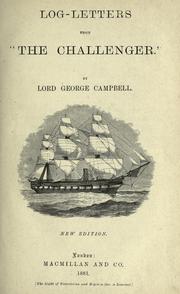
Welcome to the Bay Campus (B)log. According to the Merriam-Webster Dictionary, a blog is “a regular feature appearing as part of an online publication that typically relates to a particular topic and consists of articles and personal commentary by one or more authors”. But why (B)log? Also according to the Merriam-Webster Dictionary, a log is “the record of the rate of a ship’s speed or of her daily progress; also: the full nautical record of a ship’s voyage”. Such as “Log-letters from ‘The Challenger’” by Lord George Campbell (see left) or “The Log from the Sea of Cortez” by John Steinbeck. This series of posts will be a blog, but in a nod to our marine environs and sea-going history, it will also be a log with weekly reports and discussions of voyages (real, virtual, or imagined) of the people of GSO and their work and inspirations.
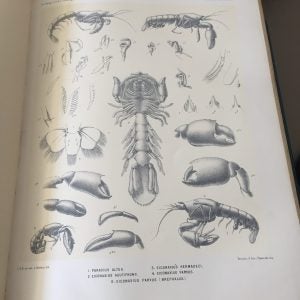
Today when you drive down South Ferry Road, and take the first right into the campus, you are greeted by the building for the Ocean Science and Exploration Center, also called OSEC. Upstairs is the Pell Library for Marine Science, a member institution of the Consortium of Rhode Island Academic and Research Libraries. Visitors are welcome. Near the entrance is the “Special Collections” Room where you can find rows and rows of the bound scientific reports of the “Challenger Expedition” which took place in 1872-1876, the first ocean voyage designed specifically to study oceanography and the plants and animals that live in the ocean in all parts of the globe. Pick up a volume and look at the illustrations of marine organisms, they identified over 4000 previously unknown species! Although the “Challenger Expedition” was a British voyage led by Charles Wyville Thomson, there is a Rhode Island connection (of course). Thomson asked his colleague and friend Alexander Agassiz to join him in the “Challenger Office” in Scotland to sort and classify specimens from the expedition and to write some of the reports, particularly those related to his specialty, Echinoderms (sea stars, sea urchins, etc.) Agassiz later wrote reports while living in his summer home, now known as Castle Hill Inn, in Newport, RI.
For researchers at the Graduate School of Oceanography (GSO), these reports are our roots and holdfasts. We are familiar with roots on land plants.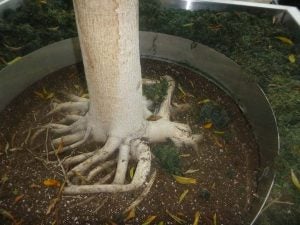 In the ocean, there are nearshore plants that have roots, such as eelgrass and other types of submerge aquatic vegetation (SAVs), or the specialized prop roots of mangroves in tropical waters that go from the trunk through the air to the water and then into the sediments, giving the tree more exposure to air and also more support. These roots not only keep the plant in place, but also allow water and nutrients to travel to other parts of the plants. Several types of marine organisms have holdfasts. According to the Merriam-Webster Dictionary, a “holdfast” is “something to which something else may be firmly secured”, or “a part by which a plant clings to a flat surface”. A holdfast does not serve as a pipeline for material but literally does “hold” seaweed “fast” to rocks, keeping the seaweed anchored. Holdfasts and prop roots, along with the whole plants of SAVs, physically provide protected environments where juvenile fish and other marine organisms can be nurtured and sheltered. The scientific reports of the “Challenger Expedition” established the science of oceanography, holding us fast to serious, methodical, investigations and explorations of the world’s oceans. And they are also our roots, a place to start and branch out from, a channel bringing nourishment and energy to us for further studies.
In the ocean, there are nearshore plants that have roots, such as eelgrass and other types of submerge aquatic vegetation (SAVs), or the specialized prop roots of mangroves in tropical waters that go from the trunk through the air to the water and then into the sediments, giving the tree more exposure to air and also more support. These roots not only keep the plant in place, but also allow water and nutrients to travel to other parts of the plants. Several types of marine organisms have holdfasts. According to the Merriam-Webster Dictionary, a “holdfast” is “something to which something else may be firmly secured”, or “a part by which a plant clings to a flat surface”. A holdfast does not serve as a pipeline for material but literally does “hold” seaweed “fast” to rocks, keeping the seaweed anchored. Holdfasts and prop roots, along with the whole plants of SAVs, physically provide protected environments where juvenile fish and other marine organisms can be nurtured and sheltered. The scientific reports of the “Challenger Expedition” established the science of oceanography, holding us fast to serious, methodical, investigations and explorations of the world’s oceans. And they are also our roots, a place to start and branch out from, a channel bringing nourishment and energy to us for further studies.
Let’s fast forward to 1934 when two special Fishes arrived in Rhode Island. That year Dr. Charles J. (Charlie) Fish joined the zoology department at what was then known as Rhode Island State College. He was accompanied by his wife, Marie Poland Fish, known as Bobbie, and both were scientists studying marine life. In 1936 Charlie was tasked with starting the Narragansett Marine Laboratory on the shores of Narragansett Bay, just down the road from the college in Kingston. Charlie’s specialty was phytoplankton and he went on to publish many scientific papers on that subject. Bobbie establish her reputation researching developmental stages of ocean fisheries and was the first to identify the egg and early larvae stages of the American eel. Because of World War II, the lab was closed from 1942 to 1948, but both Fishes continued to do oceanographic work for the Navy. Bobbie became in expert in bioacoustics, recording sounds made by hundreds of species of marine animals. Her work was particularly useful to the US Navy since it helped them distinguish between the sounds of animals and ships.
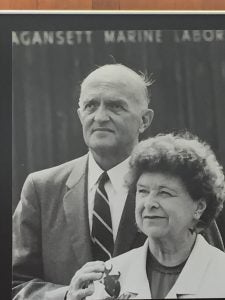
When the lab reopened in 1948, according to an interview of Charlie by Henry H. Smith that was published on September 10, 1950 in “The Rhode Islander” section of the Providence Sunday Journal Magazine, it had approximately equal funding from three sources: the state, the Office of Naval Research, and the US Fish and Wildlife Service. It also had three directives. One was to establish a graduate program to train biological oceanographers. Another was to direct applied fisheries research, mainly on quahaugs. And the third was to conduct basic oceanographic research, particularly related to global trends in plankton and fish, and underwater acoustics. In 1959 Charlie started the Narragansett Bay Fish Trawl Survey, which has continued to today. The marine lab flourished with many students, summer interns, and visiting scientists adding to the research carried out here.
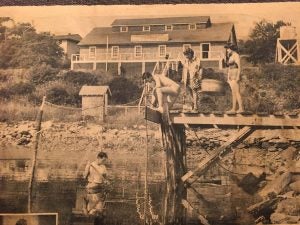
In 1960, a new laboratory building was built, hopefully sturdy enough to withstand events such as the 1938 hurricane and the 1959 fierce fire that had destroyed previous buildings and resulted in lost data, and on October 8th it was dedicated as the “Charles J. Fish Oceanographic Laboratory”. Charlie stepped down as Director to concentrate on his research. On October 21, 1983, the building was re-dedicated as the “Charles J. and Marie P. Fish Laboratory” to reflect the contributions of both of them.
In 1961, the University of Rhode Island established the Graduate School of Oceanography which included the Narragansett Marine Laboratory and started offering Master’s and Doctorate degrees. The Dean-Elect, Dr. John A. Knauss arrived later that year aboard the R/V Trident – GSO’s first ever ocean-going research vessel. She was bought for a mere $500 since she was Navy surplus. She did need some renovations, which were covered by a $300,000 grant from the Office of Naval Research.
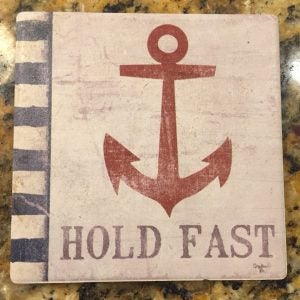 In 1966 the Navy awarded Bobbie the Distinguished Public Service Award, its highest civilian honor. Charlie, who served in the Navy, received the Navy’s Legion of Merit Award. Both Fishes retired in 1966 after long, productive careers in oceanography and received honorary Doctor of Science degrees from URI. As was noted on Charlie Fish’s Honorary Degree citation: “Thirty years ago, long before the oceans were recognized as inner space and their study was nourished with liberal federal funds, you built the university’s Narragansett Marine Laboratory into a biological oceanography center of note. Your forward-looking planning and personal concern laid the groundwork for the current development of our flourishing Narragansett Bay Campus.”
In 1966 the Navy awarded Bobbie the Distinguished Public Service Award, its highest civilian honor. Charlie, who served in the Navy, received the Navy’s Legion of Merit Award. Both Fishes retired in 1966 after long, productive careers in oceanography and received honorary Doctor of Science degrees from URI. As was noted on Charlie Fish’s Honorary Degree citation: “Thirty years ago, long before the oceans were recognized as inner space and their study was nourished with liberal federal funds, you built the university’s Narragansett Marine Laboratory into a biological oceanography center of note. Your forward-looking planning and personal concern laid the groundwork for the current development of our flourishing Narragansett Bay Campus.”
So after being rooted in the beginnings of oceanography with the Challenger Expedition, the Graduate School of Oceanography is now the anchor for the Narragansett Bay Campus, thanks to the diligent work and vision of Charles and Marie Fish.
For further reading on these topics and more photos, check out
For the Challenger Expedition, check out http://challenger-society.org.uk/History_of_the_Challenger_Expedition or take a look at the actual reports in Pell Library. Also see the book “Pioneer Oceanographer, Alexander Agassiz,” by Beryl Williams and Sam Epstein also in Pell Library,
For the early history of GSO, see the Providence Journal and Providence Evening Bulletin entries in the scrapbook: “History of GSO, Fishes, Fire, and South Ferry Church” assembled by Joyce A. Downey, Coordinator of Library Services, and located in the Pell Library. See also dates on https://web.uri.edu/about/history-and-timeline/
Volume 1; Number 1.
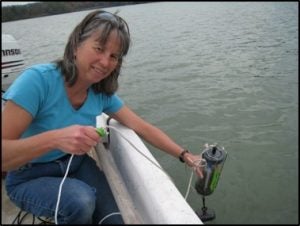 This blog post was written by Veronica M. Berounsky, GSO Science Correspondent. She first arrived at GSO in March of 1979 as a research lab tech. In 1990 she obtained her Ph.D., working on nitrification in Narragansett Bay with the late Scott W. Nixon. She continues to be fascinated by the ecology of coastal ecosystems every day. With this blog she hopes to increase your understanding of the activities and people of GSO and the Narragansett Bay Campus. Please email any comments to her at vmberounsky@uri.edu.
This blog post was written by Veronica M. Berounsky, GSO Science Correspondent. She first arrived at GSO in March of 1979 as a research lab tech. In 1990 she obtained her Ph.D., working on nitrification in Narragansett Bay with the late Scott W. Nixon. She continues to be fascinated by the ecology of coastal ecosystems every day. With this blog she hopes to increase your understanding of the activities and people of GSO and the Narragansett Bay Campus. Please email any comments to her at vmberounsky@uri.edu.
Or click here to see all previous Bay Campus (B)logs.
